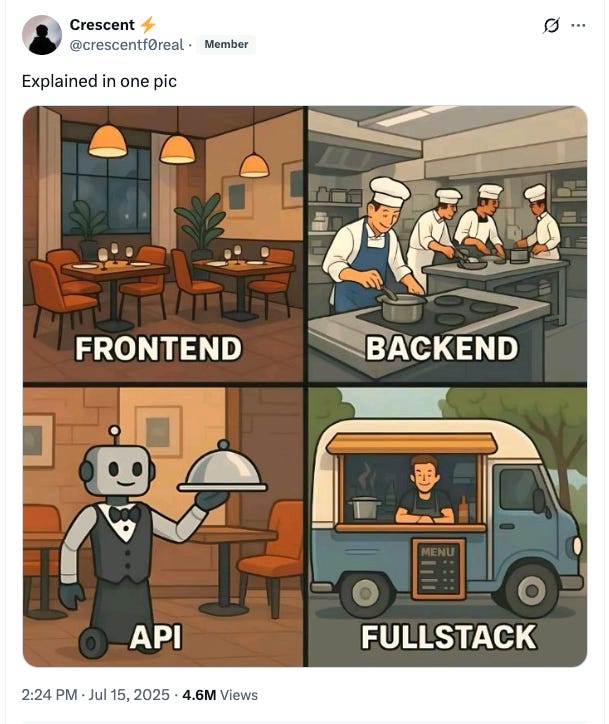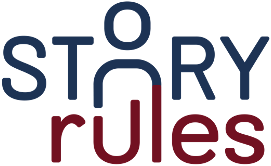China’s Growth Secret Sauce
You’d think that I would find no errors or issues in the second typeset version of the book—the one which I (and several others) have combed through in painstaking detail several times.
And yet, there they are… hiding in plain sight. I think I’ll have to resign myself to the fact that the final print will not be 100% error-free.
Did I hear you say ‘use ChatGPT’? No, thanks. While I’ve used AI for sharpening a few lines here and there, I am terrified of putting the whole thing under an LLM’s scanner. First off, I don’t want to lose my voice. And second, I’m too late in the process to go through a complete overhaul.
So the version that you get will be the all-too-human one, warts and all.
Excited to see how it finally looks!
Thanks for reading The Story Rules Newsletter! Subscribe for free to receive new posts and support my work.
And now, on to the newsletter.
Welcome to the one hundred and twenty-fifth edition of ‘3-2-1 by Story Rules‘.
A newsletter recommending good examples of storytelling across:
- 3 tweets
- 2 articles, and
- 1 long-form content piece
Let’s dive in.
𝕏 3 Tweets of the week

Agree with Kieran. It’s easy to say “delegate everything except thinking”, but tough to know where your ‘thinking’ should stop and AI’s work should begin.

Superb analogy to explain to a non-technical guy like me!

Simple yet profound.
📄 2 Articles of the week
a. ‘The Teaching Problem’ by John Tagg
Universities in the US are under fire from the current administration. While Prof Tagg clearly disapproves of that, he feels that colleges need to do a better job at education:
The main weakness of most colleges and universities is that they don’t do a very good job of educating most students. Most teachers do a mediocre job of teaching, and so most of their students do a mediocre job of learning.
This is not a new problem. University leaders have known it for… a long time:
When Charles William Eliot assumed the presidency of Harvard in 1869, he observed that “lectures alone are too often a useless expenditure of force. The lecturer pumps laboriously into sieves. The water may be wholesome but it runs through. A mind must work to grow.”
(Loved the visual water and sieve analogy!)
G.B. Shaw is supposed to have said: “The biggest problem with communication is the illusion that it has occurred”
Ditto for teaching, as this example attests:
Mazur was a “successful” teacher, gave popular lectures, and received good student evaluations. Then he came across a test that sought to assess students’ conceptual understanding of physics. When he included some of these conceptual questions in his exams, he discovered two things: “First, it is possible for students to do well on conventional problems by memorizing algorithms without understanding the underlying physics. Second, as a result of this, it is possible for a teacher, even an experienced one, to be completely misled into thinking that students have been taught effectively.”
Instead of the standard lecture-based lessons (passive learning), Prof. Mazur devised a form of active learning through peer instruction:
The teacher has assigned reading to be completed before class. He spends a few minutes outlining the key principles that his students have already read about, then he gives them a problem with four possible answers. Students have clickers with which they can send remote responses to the professor’s computer. They have a minute or two to answer the question. Then the teacher tells the students to explain to their neighbours why they answered the question as they did. Then all students answer the question a second time. Only then does the teacher display a chart of the responses before and after the brief discussion. Most of the time, there is a considerable shift in the responses towards the correct answer. Finally, the teacher asks for a volunteer to explain why the correct answer is correct.
Prof Tagg gives a few more ways to implement active learning:
There are many other ways of implementing active learning such as well-designed group discussion, small-group projects, Socratic questioning, writing, and combining these in a “flipped” classroom where students do reading and interactive prompts before class and then discuss and defend their ideas face-to-face in class.
These techniques are proven to work:
In 2014, Scott Freeman, a biologist at the University of Washington, and six colleagues conducted a massive and careful meta-analysis of 225 studies comparing student performance in classes taught by traditional lectures and classes taught using active learning techniques in eight different science, technology, engineering, and mathematics (STEM) disciplines. The difference was dramatic. Students in active learning courses did significantly better on exams than students in lecture courses. The lecture format increased failure rates by 55 percent.
Ditch lectures, embrace active learning approaches. They can transform your learning outcomes.
b. ‘The art of storytelling and fundraising with Siqi Chen’ by Phoebe Kranefuss
I’ve read countless pieces on how to craft compelling pitch decks. But this one was striking for the simple idea of the ‘sequence of emotions that a pitch should evoke’.
The writer quotes Siqi Chen, a successful founder:
…here’s the secret he’s learned through four CEO roles and three founder journeys: fundraising isn’t only about logic or numbers — it’s also about emotion. No matter what you’re building, what you’re selling to investors is a story that evokes feeling.
So far so normal. But Chen’s big idea is to think of the pitch not in terms of the logical sequence, but the emotional sequence:
Many founders approach pitch decks like a mathematical equation: problem, market, team, solution. But Chen points out that humans don’t always make decisions rationally. We tend to feel first, then rationalize. A pitch strategy should consider this.
Over the years, he’s honed a pitch strategy that’s designed to create a precise emotional journey. It starts with amusement, leads to surprise, then curiosity, builds to awe, and culminates in greed — or, in cozier terms, “big desire.”
This portion of the article is gold:
When Chen crafts a pitch, he’s not just presenting facts. He’s engineering an emotional experience. The first moments must be amusing — engaging, entertaining, exciting — enough that investors want to keep listening. Even if they don’t wind up interested in investing, he doesn’t want them to be bored. He wants that opening to be compelling enough that they remember him some years later.
Once he’s drawn them in with a relevant anecdote or a story that deserves their attention, he introduces something surprising: a unique insight or perspective that gets them to a place of curiosity. Ideally, they’ve gone from passively entertained to actively curious. As that curiosity builds, he gets them excited. He wants them thinking: this could potentially become one of the largest companies in the world! They’re excited now. They don’t want to miss out. They’re in awe, they’re feeling greedy, they want to be a part of this. And that final part — the greed — is what gets people to say yes.
🎧 1 long-form listen of the week
There are several TILs and jaw-dropping insights in this conversation—about the elements that drive China’s remarkable growth and innovation—between three consumer-startup founders and Adi Sehgal (a seasoned leader, who once led Reckitt’s business in China).
(Minor quibble: While I was loving Adi’s insights, I thought some of the hosts were interrupting him too much. Let the guest speak, folks. This is not a business review where you can interrupt whenever you want… not that you should do that even in reviews!)
The big idea that probably will stay with me from the conversation is that of organisation cycle speed:
…why are these Chinese companies winning? … the most important answer is organizational cycle speed. And what they are doing is essentially they are speeding up the organization cycle much faster. So you can also say that listen I’m not going to give you a full year target because I don’t know what it’s going to be but I damn well know that in the next quarter we are going to achieve 50%. If you achieve this then you get whatever number of points and then next quarter I may give you 50 I may give you 30 I may give you 100% (growth target) depending on what it’s going.
I heard today only that in India public companies report their earnings year on year, startups do it quarter on quarter, but in China startups are doing it week on week
If you see what’s happening in China, you can predict the future in other countries:
…if you see what’s happening in China, it really gives you a superpower because you can predict the future and to some extent the same is true of America but more of China in my opinion. … whatever happens in China today will happen in America 3 years later, Europe 7-8 years later, India maybe between 2 and 7 depending on which category
A key factor driving China’s growth was rural to urban migration:
So what ends up happening is now you’ve got 15 million people coming from rural China to urban China. You need to give those people employment. If you don’t give those people employment, you have unrest. If you have unrest, it’s not good for the party or for anybody actually. So to get them jobs you will invest in creating the infrastructure that allows industries to be created which they did. So 15 million people coming in corresponded to a 10% GDP growth every year for so many years and it absorbed all those jobs.
Adi seems to have a relatively benign view of Chinese expansionist activity in Africa and Asia—he says that they are mainly doing it to keep their people gainfully employed and protect their supply chains:
… now have this massively skilled workforce who needs to continue to have jobs otherwise there will be unrest. So China’s number one focus always is the prosperity of its people and looking inwards they in my opinion they couldn’t care less about going and controlling anybody. The only reason they are interested in controlling or appearing to control anybody is the making sure that their supply chains are secured that they get their minerals from Africa or Australia.
An interesting point was about the nature of things being exported by different countries—guess which is the developing country:
… yes there are some airplanes and there are some things but America’s primary exports are things that you would expect a third world country to export. Petroleum is the biggest export that America has (and also) agricultural products. Yes, there is about a 100 billion (dollars) of planes and high-tech but it’s very small. China—the majority of export today is high-tech.
Adi talks about how companies like Reckitt are mastering the use of platforms like TikTok through incessant experimentation to find out what works
…there’s a five-story building which is full of 50 rooms which is 24/7 live streaming… all the time. And this is in Reckitt. Reckitt is doing live streaming like you would not believe it…
Tik Tok is a platform which compresses your entire (consumer) cycle. You can get acquisition, you get people, you can get interest because you can give them something new. You can get direct click to purchase in one platform in 30 seconds. Of course, you’re going to iterate on that like crazy and have a different product every 30 minutes and have a different presenter. Someone was telling me that when they do these things they are down to the level that when they open a bottle what sound it will make and how much conversion it’ll give (based on) whether it’ll open with a plop or a topp or a tick – it makes a difference in the bloody conversion
Earlier driving a BMW was a status symbol in China. Now, its a downer:
…so (earlier) you drove a BMW because a BMW said something about you. Today when I go and I see all these people, all of them have switched from their BMWs to some Chinese car. So I asked them that my friend why have you moved to a Chinese car? … they say that, look, 10 years ago people used to look pityingly at people who were not driving BMWs … but now if we see someone who’s driving a BMW, we look pityingly at him… First of all, he is driving a car that is 20% of the quality of the (Chinese) car that I drive and second it is at double the price
I loved this joke about the factory of the future in China:
I’ve seen a factory which is the size of a football field with 500 robots with one person. They’re just saying, “No, in the factory of the future, there are two people, a man and a dog. Why is the man there? To feed the dog. Why is the dog there? To prevent the man from touching the machine.”
That’s all from this week’s edition.
Photo by Diana Polekhina on Unsplash







